by Winding Pathways | Jan 22, 2015 | Reflections/Profiles, Wonderment
“Hope” is like “Why”.
Jenion’s Blog, “Don’t Ask Me Why”, really stuck with me – How we use words to either ropel ourselves forward or hold ourselves back.
Her take was that “Why” – that annoying three year old habit of asking – is too often used to be an excuse for perceived injustices or not doing something. We revert to “three-year-oldism” as adults: “Why me?” “Why did this have to happen?”
Then, after Sunday’s service and sermon connecting Hope with Martin Luther King, Jr. Day, I looked at “Hope.”
“Hope” as defined is “a feeling of expectation and desire for a certain thing to happen.” Synonyms include Wish, Desire, Aspiration, Expectation, Goal, Aim, Plan. I listed these is ascending order of “just sittin’ complainin'” to “I can do this.”
The above words are compatible with the archaic definition – “A feeling of Trust.” Do we trust in ourselves enough to step out of complacency? Do we trust that available systems exist to help us along?
As the Reverend Jeff Briere pointed out, we put our keys in the same place so we know where they are. We put our glasses in the same place so we can get them easily and can use them. We store our phone numbers on our cell phones so we can quickly access them. Where do we put “Hope”?
His advice is to put “Hope” somewhere so you can find it easily. Wear it. Keep it clean. Nurture it.
We know that Hope is critical to survival and thriving. Elie Wiesel writes and speaks powerfully of Hope, the importance of Memory, and the human condition.
Yet, it seems a somewhat elusive quality. Without it, sinking into numbed sameness is easy. Deer Hunting With Jesus by Joe Bageant examines the hopeless conundrum of the working class folks who have been stiffed by the establishment. The working and middle income members of society who are our backbone, feel they are “making it OK” when in reality, they are sinking further behind – economically and in opportunity to improve.
Things can seem confusing and hopeless. What to do?
First, ask “Why?” Not in the whining tone of hopelessness. Keep asking “Why?” until you reach the root of your question..
Second find Hope – even if it is just a fragment. Then, Clean it off. Wear it. Keep it clean. Put it where you can easily find it. Build on it. Celebrate it. Share it.
Send Winding Pathways about how you cultivate Hope. What inspires you? Where do you keep Hope so you can easily find it? What image of Hope captures your imagination?
We’ve chosen for the featured image a double rainbow over Lake Okoboji, Iowa. These words from Genesis 9:13 of the New International Version of the Bible. “I have set my rainbow in the clouds, and it will be the sign of the covenant between me and the earth.” Hope.
by Winding Pathways | Nov 17, 2014 | Chickens, Children/Play, Nature, Reflections/Profiles, Wonderment
First Snow has a magic that draws children to it. Even some adults “get into” a first snow. Share your adventures and memories – current or past – of a First Snow. (Or any winter adventure you cherish.) Let us sparkle with life. For those who prefer to enjoy winter inside curled up with a good story, Robert Frost’s “Stopping By Woods On Snowy Evening” or John Greenleaf Whittier’s “Snowbound” both at Poetry Foundation are terrific reads.
*The idea of posting about the magic of first snow was inspired by Wahneta Tonn Dimmer’s FB post and hearing our neighbors’ children laugh as they belly slid down a slope by their home. Yes snow has its hazards and needs to be shoveled. But we can whistle while we work and appreciate the beauty of an Iowa winter in November.
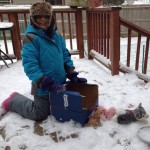
First Snow is magical.
Devany Souza – musher extraordinaire
“I was dog-sledding to Alaska. I had some medicine for the
children and all the grown ups who were sick. I put the medicine
in the box, with a blanket under it and on top of it, so it wouldn’t freeze. And the lead dog was my Husky named ‘Snowflake’.
The dogs’ paws froze and I had to put them in my sled and
push the sled until I got to Alaska. When I got to Alaska, everyone
got out of their cottages and cheered. I let my dogs off their harness and a lot of children came up and started petting them and they built
a statue of the three dogs and a statue of me. The End.”
Devany Souza as dictated to her mom, Kelly Carr Souza.
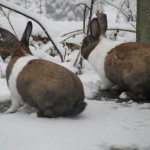
Considering their options.
Plotting a Winter Escapade
Summer Bunny and Jumping Bean were two intrepid Tortoise Shell Dutch Bunnies who loved to explore in summer and winter. They like the paths that we shoved for them best, but they were little deterred by snow. Hilarious to watch, they would seem to plot their adventures. Usually their paths took them under the gnarliest branches and into the thorniest thickets.
After a suitable romp they usually were ready to come back to the hutch for a snack and warming up in their bunny box. They always made winter fun.
“Hygge”

The infant snuggled close to her mama as snow drifted down outside.
“I made a conscious decision to stay home today. I did not touch my car, or anyone else’s car. We had a warm breakfast. We wore comfortable clothes. Around 11:00 a.m. the neighbor girl came over and drew my older daughter outdoors, where they mostly stayed until about 4:30 p.m., reveling in the newly fallen snow. Too powdery for snowmen or snowballs, but good for pulling a sled! My little one, of course, was intrigued by her older sister’s adventures. I found too-big snow pants for her and rolled up the legs; put on her coat and hat, and held her little hand as she shuffled down the sidewalk. In the afternoon, we had chicken noodle soup and a nap. I read my book. To the little one’s delight, we were not separated by more than an inch for most of the day. My sister came to visit and we toasted with a couple of glasses of wine and ate some salmon. I recently read about Danish “hygge”; there’s no good translation to English but it could be thought of as coziness, togetherness, and well-being that gets us through winter. We may have discovered it in Iowa already this winter! I hope it carries us through.” Sophie Nicholson
The Magic of Winter

A typical winter scene – an assortment of gloves, mittens, hats, scarves all returned from a day on the snowy slopes.
“Children know how to do it right, celebrate winter that is! Watch the excitement in their eyes as the first snow flakes fall, then as the snow begins to accumulate on the grass, trees, patio swing and sidewalk. “Do you think it will be enough to go sledding, Mom?” my son asked.
“As a child I was fortunate enough to grow up in a five acre wood that was once home to a ski jump in rural Wisconsin. My brother, two cousins and friends from the neighborhood would bundle up and brave the Wisconsin winter cold for the thrill of the descent. From our side of the hill, we would climb a narrow, well worn trail through the woods. As we approached the top the ski slope would open up to reveal the valley to the south. We were well protected from any wintery winds by the tall hardwoods that lined the ski slope.
“The ride down was well worth the long trek up through the woods. The hill always kept its promise of a fast and exciting ride down. We would often have races to see who could reach the bottom first! I can only imagine in the stillness of the snowy countryside, that our giggles and squeals could be heard far and wide. When we just couldn’t bear walking up the hill one more time, our sled seemed like 50 pounds instead of five, our mittens were just too wet and our toes too cold, we would trek back down the trail in the woods. Mom would surely have hot cocoa and warm wintery treats waiting upon our return. She would welcome us home, pink cheeks and all. She would want to hear every detail of our adventure.
“What strikes me most in hindsight is the realization that we never worried about the time. We were so engrossed in the wonderful experience, the joy of it, the thrill of it, that we had not a care in the world. We were truly present and enthralled by the experiences that winter had blessed us with.
“An old friend once said, “It is not really about bad weather. It is really about having the right gear.” Whether you choose to bundle up and dive into the snow and cold or have the opportunity to witness the magic through a child’s eyes, allow yourself to get caught up in it. Magic is all around us. Take time to see it and experience it!” Wahneta Tonn Dimmer
The Severins welcome winter’s first snow with
the magical spirit of children.
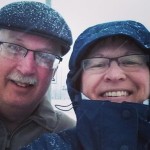
The Severins take on winter with a smile and dinner out!
“The first snowfall of the season descended in large fluffy clumps … the kind of snowflakes you want to try to catch on your tongue … the kind of snowflakes that sparkle and glisten in the light from the street lamps. We ventured out into the snowy night and shared in its magic.”
by Winding Pathways | Nov 10, 2014 | Geology/Weather, Nature, Reflections/Profiles, Wonderment
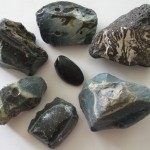
Obsidian has one characteristic that slag generally lacks – a hint of translucence.
On our recent Antiquities Tour, Rich and I came across interesting rocks on an abandoned railroad bed in Eastern Colorado. The chunks looked like obsidian. They fractured like obsidian and had the feel of obsidian. But, they didn’t quite look right. But blue and pretty! So, we put a bunch in the car. Rich was excited.
One of my geologists colleagues confirmed my observation on the fracturing and glassy feel of the rocks. But, they didn’t have the slightly translucent look of obsidian. Still I like them. So, I gave some to friends.
One scientist friend, Linda Mueller, appreciated the rock and investigated further. Here is our conversation on FB.
“I’ve been asking around about the rock you gave me. The consensus seems to be that the colors indicate that it’s slag glass and not obsidian. Certain areas in Colorado use it as railroad ballast. Obsidian and glass slag are so similar that it’s often difficult the tell the difference. Unscrupulous ebay sellers have taken advantage of this and have sold the artificial form as the real thing.
“Anyhow, whatever it is, I’m still fascinated by it. It’s beautiful and it will remain on my desk as a paperweight. Thank you again for it.”
I replied, “Thanks for checking this out!”
Linda added, “I was hoping for something interesting like turquoise. Still the stone is calming in a odd sort of way. It’s cool to the touch and smooth among the rough (parts).”
My thought: “Maybe good energy can come from slag. Say, that might be a good blog! Help me write it?”
So Linda did the work!
Linda: “I think so. The rock is truly entrancing. I can’t explain it. From the moment I saw it, I was fascinated by it. It was a special gift. I truly mean that.
“When you think about it, it does look a lot like obsidian, which is volcanic glass. I can’t remember what you said the spiritual properties of obsidian are but I wonder if they mirror the history of the stone? A huge amount of geothermal energy is needed to create obsidian. It flows from a volcano, then cools and solidifies. Tension moving toward calm? (Great analogy, I thought!)
“Glass slag is similar to obsidian; it, too, consists mainly of silica dioxide. It’s formed by heating ores (rock) to high temperatures. It’s a human-made rock, but it’s not a new technique. Humans have been creating it since the late bronze age (1500 – 1000 BCE). At least three thousand years! Wow! Ancient man found other uses for the leftover glass slag. They recycled it even then. Somehow we lost sight of that when technology gave us easier ways to make glass and pottery. Now we’ve come full circle and have found uses for it again.
“Might glass slag have properties similar to obsidian since the two are so similar? When I hold the rock, I feel calm. It takes away tension. The coolness and the weight of the stone is comfortable. Like obsidian, it was formed from heat/molten rock (tension) and it’s present state is cool/solid rock (calm).
“When you think about it, it fits. You and I have a strong interest in preservation, recycling, taking care of the earth. The rock cries out:
“‘Hey, look at the beauty and usefulness I have! Quit taking rocks from the earth to crush for railroad ballast when you already have me. I was needed for another purpose and now that it is complete, I’m moving on to my next one.’
“Everyone I’ve shown it to has had positive reactions to it. I wonder why that is?”
So, our on-line conversation ended here. But perhaps readers can weigh in and add to this. Obsidian or Slag – What Does it Matter?
The gift had the intention of love, perhaps that is a clue.
by Winding Pathways | Aug 25, 2014 | Labyrinths, Reflections/Profiles, Wonderment
Hot. Humid. Still. Not exactly an optimal day or time to walk a labyrinth. Necessary.
For weeks I have known that the labyrinth needed tending. The blooming grasses have shot up toward the sun and lodged over. Some completely block the path. Searching for the light, others have crowded into and narrowed the path. Deer have ripped off plant tops. The bird bath is dry. One area has too much sun. Plants are overly exuberant. Another has too much shade. Plants are withered. Creeping Charlie has overwhelmed the stepping stones. Too much and too little of everything. Everything feels out of balance.
Pausing, I begin to notice the beauty. My attitude shifts. Butterflies and other pollinators busily work the flowers. The occasional, slight breeze passes grass pollens plant to plant. The lyrical chatter of the goldfinches undulating across the yard brightens the day. In the shade a random breeze cools my skin. Suddenly the path widens – grace of my imperfect planning. Black Eyed Susans and nodding onions ready to harvest. Tiny purple blooms peek out from the robust prairie forbs. The magnolia pods are set for next spring.
As I notice the plants leaning into the light, Universe and I have a conversation. Behaviors are the manifestation of the negative energies that have persisted in the building and congregation. “What is my role?”
“A labyrinth walk for healing.”
Then, the counter thought: “Those who choose to heal will be here. Those who choose not to heal will not.” (And those who have been deeply wounded, will need to decide.) So, preaching to the choir. But it doesn’t invalidate the experience.
A Pema Chodron quote keeps coming to mind. “Our true nature is like a precious jewel: although it may be temporarily buried in mud, it remains completely brilliant and unaffected. We simply have to uncover it.”
“Simply.” That is the rub. Robyn M-K and Maria K’s service Sunday spoke to “covenant.” From the French covenir and earlier – Latin – covenire – “come together.” About “relationship.” What kind of relationships do we wish to have and in what ways can we move most successfully in these directions of “right relationships”? How do we relate to those who are hurt – even by their own actions? And those on the side who receive the hurt.
Unanswered.
On the way out I re-entered the heat and sun, spotting blooms that I missed on the way in. Joyful. I pushed aside the lodged grasses, intent on my mission. Blocks yielded easily.
Now what. Tranquility isn’t always easy to sort through.
by Winding Pathways | Aug 12, 2014 | Labyrinths, Nature, Reflections/Profiles, Wonderment

Resting.
Recently, a friend and I took a brisk walk punctuated by a “pucka brush” adventure. We ambled along a wide trail under trees, jumped over poison ivy, picked off stick tights, sweated and stepped in “scat”. Charming.
We spotted the most diminutive caterpillars ever – now officially named “toddler wooly bears”.
We paused to admire what I tentatively have identified as Polygonia comma (Eastern Comma) and Speyeria aphrodite (Aphrodite Fritillary) butterflies as well as Monarchs and Swallowtails.
Through the camera lens we captured Joe Pyeweed and goldenrod blooms against the dark woods green.
And, I came home feeling tranquil.
The afternoon was consumed with computer work, trying to figure out how to….you name it. Thank goodness Winding Pathways has an excellent Web Developer who, even at long distance keeps in close contact and fixes the “whatevers.” By the end of the evening I felt drained.
So, I wondered, what is tranquility? Defined as “The quality or state of being calm,” I have decided that tranquility has many faces. A person can be active yet tranquil – think running meditations or wandering though the “pucka brush”. The repetitious movements of ironing or gardening can be tranquil. Sitting quietly and watching industrious insects gather nectar and pollen, hummingbirds chase each other and rabbits forage on clover all can be tranquil.
Any activity that neutralizes the angst, the compulsive “gotta do” state that we regularly live in and transforms it to a sense of peacefulness can promote tranquility. But, this state of being is ephemeral and elusive.
Just as the early spring flowers bloom and disappear within a few weeks, tranquility will seem to pass all too soon. Are we failures? No. Like these tender blossoms it lies just beneath the surface. And, like the spring ephemerals, tranquility will return especially when we “tend the soil” so to speak. We can choose to access the state of tranquility any time.
Herein lies the elusive. To allow tranquility to touch us takes a certain amount of awareness and surrender. Allow the active mind to flow into settled stillness. Not emptiness – stillness.
Think of the ocean buffeted by winds and storms, cris-crossed by boats and littered with floating detritus. The surface is often rough and turbid. Not far below, currents flow more slowly and water begins to clear. Objects sink through the water. Heavier ones land on the bottom. Lighter ones, like silt, plants and plastics, hang suspended somewhere in between. At the depths of the ocean submarine currents move slowly influenced by density and temperature differences. Our thoughts can be like that, too. At some point our minds like water become clear.
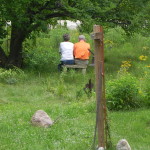
Connected to each other and the earth, we can find tranquility.
To best access the state of tranquility, remember its ephemeral nature. We are not “less” when we are un-tranquil. We are just “on the surface” of daily activities. Grace and ease lie just below this patina of our exterior nature. So, we can choose to surrender into tranquility and be the ease, grace, joy and empowerment we are meant to be.
For me connecting with nature helps me attain tranquility. With the Laughing Labyrinth in our front yard the transition is usually simple. Then, I flow with ease, grace, joy and empowerment – even when I have stepped in scat.
by Winding Pathways | Jul 31, 2014 | Reflections/Profiles, Wonderment
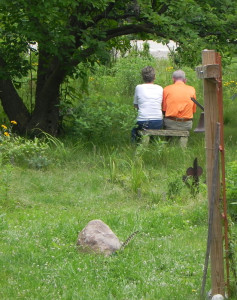
Enjoying quiet after a stressful day.
A home and yard can be a place to find peace and tranquility in a stress filled world. Many recent studies reveal that being embraced by nature’s beauty offers stillness that calms the soul. But, it does more.
Being in nature lowers blood pressure, stimulates the imagination, provides exercise and satisfaction, and nurtures creativity. Many people trek to distant parks, wildlife refuges, and wilderness areas to harvest nature’s peace. All good ventures.
Winding Pathways encourages people to create a wonderful natural area in the place where we spend the most time – at home.
The tiniest yard or even an apartment balcony can be coaxed into a space of beauty and peace.
Winding Pathways offers tips on how to transition a mowed and sprayed yard into one that provides the tranquility we need.
Your yard is the best place to unwind after a hectic day, and Winding Pathways will help make that yard a wondrous place.
There’s more to tranquility than the yard. We’re all bombarded by news reports of massive home-destroying storms and millions of people left without power. Winding Pathways will help you build peace of mind by showing you how to prepare for power outages, tutoring you in how to grow and find food in the yard, and helping you remember how to enjoy the simple quiet solitude in the back yard.
Your yard is also a place for adventure, especially for children and grandchildren. Bumblebees, woodpeckers, clover rings night crawlers, opossums and more are all fascinating to youngsters. A yard with places to explore, quiet nooks to hide in, and curious things to discover is a place of joy.
Winding Pathways will encourage you to craft your yard for your tranquility and a child’s wonder.
Co-owner Marion Patterson is the “tranquility guide.” In addition to sharing tips on how to nurture and enjoy a diverse and ecologically healthy yard she encourages you to connect with your inner space. Among the options is creating a contemplative labyrinth, exploring the quiet spaces within ourselves, and participating in spiritual retreats.









